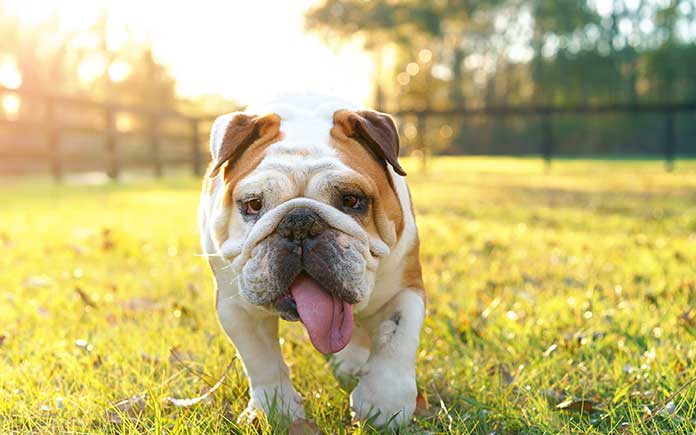
If you’re a homeowner who puts a lot of effort and attention into maintaining a lush and healthy lawn, the last thing you want is someone’s dog coming into your yard and ruining all your hard work. Roaming pups can do a number on your flower beds and green grass.
The Today’s Homeowner reviews team has taken a look at the most effective home remedies that will keep dogs off your meticulously maintained lawn. This guide also discusses commercial dog repellents and shares tips on how you can prevent your dogs, the neighbor’s dogs, or strays from doing further damage to your lawn.
Today’s Homeowner works with an independent reviews team to create evidence-based research that helps our readers make informed decisions. The reviews are always independent. For transparency, we may be compensated if you purchase through a link.
Use Specially Designed Commercial Dog Repellent
If you put a lot of effort into maintaining your lawn, the last thing you would want to see is dogs chewing plants, digging or leaving their “presents” lying around for you and guests to step in. Fortunately for homeowners, there are plenty of specially designed commercial dog repellents available on the market. These products will help you deter unwanted strays or prevent your stubborn and mischievous pooch from damaging your garden.
There are two kinds of dog repellents — granular and liquid. Both types work in the same way and have the same active ingredients. Granular repellents are more effective if you’re aiming to create a boundary area around your lawn or wall off certain parts of your garden. On the other hand, liquid dog deterrents are the better choice if you want to target specific plants or items in your lawn that are particularly inviting to dogs.
Where You Can Buy Dog Repellent
Commercial dog repellent solutions are widely available. You can find them at almost every pet store or pet pharmacy. You can even order them from Amazon if you prefer shopping online, as there are dozens of online sellers.
What Ingredients Are in A Commercial-Made Dog Repellent
The ingredients can vary depending on the specific type or brand of dog repellent. The most important ingredient that makes up commercial-made pest deterrents is methyl nonyl ketone, a colorless oil with a powerful odor. Typically, 1-2% concentrations of this compound are found in repellents. Methyl nonyl ketone is very efficient at repelling both insects and animals.
How to Use Dog Repellents
The application process is vital, so make sure to read the instructions on the back of the bottle before applying the repellent to your lawn. If you’re using liquid repellents, only apply them in dry weather and temperatures above 40 degrees Fahrenheit. Be careful when applying the repellent and reapply it periodically so it stays effective year-round.
How Long Before You See Results
Don’t get discouraged if the repellent doesn’t start working immediately. Usually, it will take at least a few encounters with your repellent before a dog starts associating their discomfort with that protected part of the lawn. Dogs learn by picking up patterns, so it will take some time before the canine offender figures out what parts of the yard are off-limits to his shenanigans.
Going Old-Fashioned: Remedies You Can Make in Your Kitchen
If you don’t want to use specially designed dog repellents, there are quite a few old-fashioned remedies you can apply on your own. Take into account that these home remedies are often hit or miss, and there isn’t a surefire way that will always provide you with the same results. With that said, let’s take a look at the most popular dog repellents you can find in your kitchen.
Almond Oil
Almond oil contains a lot of nutrients and vitamins and is a very popular dog-conditioning formula. It helps repel fleas and controls shedding. But, what a lot of people don’t know is that the scent of almond oil is also unpleasant to dogs. Much like olive oil or similar oil-based formulas, almond oil will keep your dog far away from every surface you spray it on.
Garlic
Due to its pungent smell, garlic is a highly potent dog deterrent. Moreover, it’s not toxic, and you probably have it in your kitchen cabinets or fridge. To apply it on your lawn, you’ll first need to mince the garlic and mix it with about four cups of lukewarm water. Allow the garlic mixture to sit for 24 hours. Next, strain the liquid and pour it into a spray bottle. Then, apply to the places in your yard that you want to keep dog-free.
Cayenne Pepper or Chili Pepper
Cayenne pepper is a very effective dog deterrent because it contains large amounts of capsaicin. This ingredient is used in self-defense sprays, designed to repel aggressive animals. Capsaicin is often recommended as a rodent and insect repellent, too. Making a low-concentrated spray consisting of one part cayenne powder and 10 parts water and spraying it on plants will prevent your pet from licking or chewing the plants. But, cayenne pepper isn’t always an ideal solution. While it won’t harm your dog if swallowed, the pepper may sometimes irritate his eyes, nose, or genitals. This is why you should be careful when dosing and applying the pepper on your lawn.
Ammonia and Vinegar
Ammonia and vinegar are probably two of the most effective dog repellents you can find in your house. When spraying vinegar or ammonia, only spread them throughout your garden in strips and don’t apply the mixture directly to your plants. While the smell might be overwhelming for you, it will also help your dog understand that he’s doing something unacceptable in the area where he smells this homemade deterrent. Take into consideration that overapplying ammonia and vinegar on your lawn could damage your grass. So be careful when using an ammonia and vinegar dog repellent.
Plant Your Garden Wisely
If you want to prevent your pets from running amok in your garden, you can grow a few types of plants that will naturally deter dogs from coming too close. Keep in mind that we’re going to list only the plants that specifically discourage dogs from damaging a garden—not other pests. While some plant species are toxic to dogs, this list doesn’t include any plants that may be harmful to your pets. A few of the most common dog-repelling plants are:
- Lavender — Unlike humans, dogs dislike the scent of lavender. Although some dogs might enjoy the aromatic smell, they’re in the minority. Most breeds will find lavender far too potent for their advanced sense of smell.
- Citronella — This popular mosquito-repelling plant also deters dogs as well as cats from entering the garden. You can even squeeze out the oil in citronella and spray it on the areas you don’t want your pets to go.
- Scaredy Cat Plant — Plectranthus caninus is often advertised under the name Coleus Canina, or the scaredy cat plant. It’s said to have a strong and very repelling odor to animals. But humans can’t detect the smell unless they crush the leaves or rub against the plant.

Fertilize With a Plan and Go Organic
Switching to an organic fertilizer can also make dogs avoid your lawn. This is because they’re very sensitive to organic smells, so a strong organic fertilizer will throw off their sniffer. Going organic will provide you with a slow release of nutrients and keep your grass healthy and strong for more extended periods. Organic is also safer for the environment.
If you decide to go with an organic fertilizer, make sure to pick the correct type for your lawn and gardening goals. Avoid fertilizer that could be attractive to dogs, such as fish and bone meal or similar animal-based fertilizers. Instead, choose plant-based options, which will deter dogs and won’t entice them to dig around in your lawn and uproot your prized rosebush.
Spook Dogs With a Sprinkler
If you don’t want to go through the endless process of applying and reapplying commercial and home-made deterrents, you could set up motion-activated sprinklers in your lawn. The spray, along with the noise it produces when working, are sure to frighten off dogs and keep them from wandering onto your property.
Motion-activated sprinklers are quick and simple to install and provide around-the-clock monitoring. While the initial cost of installing motion-activated sprinklers is higher than buying a repellent, it’s a more efficient and economical choice in the long run. Plus, using water sprinklers to repel dogs is a much safer alternative to using chemical repellents.
Make It Known Your Lawn Is Off-Limits
If the previous prevention methods prove to be insufficient, you can also make it known that other dogs aren’t welcome on your lawn. Setup noticeable warning signs in front of your garden to stop the neighbor’s dog from peeing and pooping in your yard. You can use descriptions like Clean up After Your Dogs and No Trespassing to express your dislikes about neighbor’s dogs doing their business on your lawn. This is not only a polite way of dealing with such an issue but also a very effective one. Your neighbors won’t have any plausible excuse that they didn’t know the area was off-limits.
Rally the Neighborhood
If you’re having an ongoing problem with dogs damaging your lawn, you should try telling your neighbors and resolve the issue with communication. Sometimes, people aren’t aware that their dogs are wandering into your lawn. Good communication between neighbors can make it less likely that someone else’s dog will muck up your flowers or pee in your garden.
Even if your neighbors aren’t that understanding, you can put up signs saying your yard is being treated for other pests, and that these treatments can be dangerous for dogs. Other pet owners who see these signs will likely be more careful and keep a better watch on their dogs.
What if no one owns the offending canines, and they’re strays? If your block has a stray dog problem, rally the neighborhood and try to get the strays off the streets. Often, when the entire community joins forces, the local authorities will fix the problem quickly and efficiently.
Going with the Pros
With the tips we’ve shared with you on this page, you’ll have a much better chance of keeping your lawn beautiful, healthy, and pest-free. Even though you can accomplish a lot by yourself, sometimes the damage is too great.
But a professional can restore your lawn for an affordable price. If your lawn is damaged by dog urine or excessive foot traffic, don’t hesitate to contact a professional lawn care company. A lawn care company can advise you on the best steps to take to improve the health and quality of your yard. Professional lawn care technicians will also provide you with the most suitable products that will get your lawn back in shape in no time.
Top Pick: TruGreen
When it comes to professional lawn care companies, TruGreen ranks best overall. After reviewing the best lawn care companies in the country, comparing prices, user reviews, and many other factors, the review team’s choice comes down to this service. TruGreen is affordable, reliable, and offers a wide variety of lawn care services that cover everything from fertilization and overseeding to tree and shrub care.
TruGreen is available nearly nationwide, excluding Alaska and Hawaii, and is the nation’s largest lawn care company.
If you’re looking to book a professional lawn care service, call TruGreen at 877-820-0392 or fill out asimple form to get a free quote.
Frequently Asked Questions
Will cayenne pepper deter dogs?
Because of its spicy nature, cayenne pepper will keep dogs from approaching the areas where you apply it. Though it’s not toxic for dogs, it can irritate their eyes and other sensitive areas that come into contact with it. Cayenne pepper will keep dogs from your lawn but is certainly one of the more extreme solutions compared to other homemade dog deterrents.
What is the best dog repellent for lawns?
Commercially made dog repellents are the most effective, although the home remedies we shared will also go a long way into keeping your lawn pristine. But you’ll need to be cautious when applying a mixture as a dog repellent. Certain repellents can harm your dog. Pest repellents like mothballs, detergents, coffee grounds and excessively applied garlic and pepper solutions can endanger your dog’s health. Always do your research before you apply a repellent to keep dogs off your lawn.
How can I get dogs to stop pooping on my lawn?
The simplest way to keep dogs from pooping on your lawn is to erect a fence or a hedge barrier. Commercially made repellents, natural smells from plants, fertilizers and homemade ingredients can also help in preventing your dog or the neighbor’s dogs from pooping on your lawn. Also, make sure to create a “poo zone” for your pup, and train your dog to go only on that area instead of using the entire lawn as his toilet.



